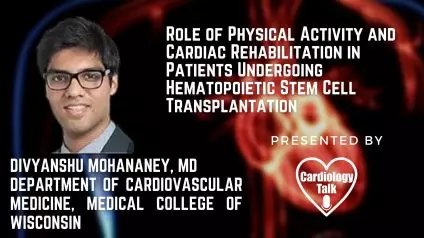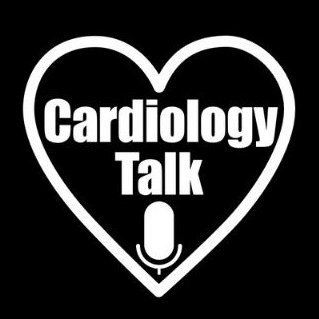Divyanshu Mohananey, MD- Role of Physical Activity and Cardiac Rehabilitation in Patients Undergoing Hematopoietic St...
Dr. Divyanshu Monhananey works as a third year Cardiology Fellow at the Medical College of Wisconsin. He attended Maulana Azad Medical College in India and did his residency at John H. Stroger Jr. Hospital of Cook County in Chicago, Illinois. In this video Dr. Mohanaey talks about the Role of Physical Activity and Cardiac Rehabilitation in Patients Undergoing Hematopoietic Stem Cell Transplantation.
Link to Abstract-
https://www.sciencedirect.com/science/article/pii/S2666087321000193#!
Abstract
Hematopoietic stem cell transplantation (HSCT) is a routine treatment for a variety of cancers, with over 50,000 HSCTs performed each year throughout the world. Cardiovascular disease and associated risk factors have become a substantial cause of morbidity and mortality in this population as survival following HSCT improves. In this post, we go over the risk factors for cardiovascular disease and how they affect HSCT patients. In addition, we examine the data on the effects of physical activity in patients having HSCT. Despite significant variation in methodology, small sample sizes, attrition, and a lack of long-term cardiovascular follow-up in this patient population, the majority of these studies support the favorable effects of physical activity and exercise. Cardiac rehabilitation (CR) is an organized exercise and lifestyle modification program used to treat people who have had a heart attack or stroke. We examine the data on CR in oncologic and nononcologic populations in order to provide a framework for CR application in HSCT patients.
Hematopoietic stem cell transplantation (HSCT) is a curative therapeutic option for a variety of malignant and nonmalignant hematologic disorders. More than 50,000 HSCTs are conducted annually worldwide (1), with 23,706 HSCTs performed in the United States in 2018 according to the Center for International Blood and Marrow Transplant Research (2). With advancements in transplant procedures, the life expectancy of HSCT survivors continues to improve, with an estimated 502,000 HSCT survivors by 2030. (3, 4, 5). However, the higher risk of non–disease-specific long-term consequences has been linked to the observed improvement in survival after HSCT. Cardiovascular disease (CVD) and its related risk factors, in particular, have a major negative influence on long-term morbidity and death following HSCT (6).
Physical activity, according to the Centers for Disease Control and Prevention, is an effective treatment and prevention method for chronic diseases such as CVD, metabolic syndrome, and some malignancies in the general population (7). These findings imply that physical activity leads to improvements not just in terms of physiological health but also in terms of overall health-related quality of life (8). Cardiac rehabilitation (CR) is a structured comprehensive exercise and lifestyle modification program that is widely used in cardiovascular practice following a myocardial infarction (MI), in patients with stable angina or heart failure, and after percutaneous coronary interventions (PCI) and cardiac surgery.
We assess published findings on the feasibility, implementation, and outcomes of exercise therapy and cardiac rehabilitation in this review, and we offer a paradigm for implementing these treatments in the expanding HSCT population.
CVD's Burden and Risk Factors Affecting HSCT Outcomes
Long-term survival after HSCT is dependent on several factors, including patient characteristics, prior cancer treatment, disease risk stratification, and transplant-related outcomes, despite the fact that HSCT has significantly improved the potential for cure and survival in patients with hematologic malignancies. The 10-year survival rate was 85 percent in a large cohort of patients who were alive and disease free after 2 years of allogeneic HSCT (3). Patients who were relapse-free for 5 years after autologous HSCT had an 80 percent 20-year survival rate (9). Long-term CVD and CVD risk factors, on the other hand, are a major cause of morbidity and mortality among these survivors, and are frequently related to prior cancer therapy as well as cardiovascular difficulties linked with HSCT. HSCT recipients have a higher risk of developing CVD risk factors, with reported incidence rates of hypertension ranging from 28% to 74%, diabetes from 10% to 41%, dyslipidemia from 33% to 58 percent, and obesity from 20% to 44%. In comparison to the general population, HSCT survivors have a 7- to 16-fold greater incidence of CVD risk factors (10, 11, 12).
Similarly, HSCT survivors have a higher risk of overt CVD, with a reported incidence of MI, heart failure, and arrhythmias of 1% to 9%, 2% to 12%, and 2% to 13%, respectively (11, 12, 13, 14, 15, 16), and a median age for overt CVD of 54 years vs. 67 years, respectively (11,17,18). Furthermore, HSCT survivors had a 2- to 4-fold higher risk of CVD death than the general population (15,19). Despite the fact that advanced age is a well-established independent risk factor for CVD (20), advances in HSCT procedures have enabled HSCT to be offered to the elderly population. To that aim, patients aged 60 and more accounted for 39 percent of allogeneic HSCT recipients and 55 percent of autologous HSCT recipients in 2018. (2).
Direct organ damage from therapeutic exposure to chemotherapy and/or radiation, as well as indirect harm from graft-versus-host disease (GVHD), pre-existing CVD risk factors, and functional handicap, are likely to contribute to the increased burden of CVD and related risk factors in HSCT recipients (16). Chemotherapeutic drugs used as part of primary treatment or preparative regimens, such as anthracyclines (3 percent to 26 percent) and high-dose cyclophosphamide (28 percent), have been linked to heart failure (20, 21, 22, 23). In comparison to autologous HSCT, allogeneic HSCT survivors have a higher incidence of cardiovascular risk factors such as hypertension, diabetes, and dyslipidemia (10). These risk factors are more common in patients who develop GVHD, and it's been suggested that the allogeneic reaction may speed up the atherosclerotic process (10). Furthermore, the 10-year cumulative incidences of elevated blood pressure, elevated glucose, low high-density lipoprotein cholesterol, hypertriglyceridemia, and obesity were 8.8%, 33.1 percent, 52.0 percent, 65.0 percent, and 18.6 percent, respectively, in an analysis of 123 HSCT survivors, of whom 95.9% underwent allogeneic transplantation and all were treated with total-body irradiation (24).
Furthermore, HSCT recipients must stay in the hospital for an average of four weeks or longer. Patients are frequently critically unwell, lose muscle mass, and acquire diminished exercise ability over this lengthy stay (16). Although there is a lack of data on the effects of prolonged inpatient stay on CVD sequelae in HSCT patients, studies in nononcologic patients can be used to extrapolate the impact. According to one study, 3-weeks of bed rest can cause cardiovascular fitness to deteriorate at the same rate as a 40-year aging process (25,26). Given the accompanying higher CVD risks, the impact of prolonged bed rest on cardiopulmonary fitness in HSCT patients is anticipated to be greater than in otherwise healthy individuals.
Physical Activity as a Treatment Option for HSCT Patients
Adults should engage in at least 150 to 300 minutes of moderate-intensity or 75 to 150 minutes of vigorous-intensity aerobic physical activity per week, as well as muscle-strengthening activities 2 or more days per week, according to physical activity guidelines developed by a federal advisory committee and the US Department of Health and Human Services (27). According to the American College of Sports Medicine (ACSM), an effective exercise prescription for cancer patients should include moderate-intensity aerobic training (at least 3 times per week, for at least 30 minutes, for at least 8 to 12 weeks) and resistance training (at least 2 times per week, using at least 2 sets of 8 to 15 repetitions of at least 60% of 1 repetition maximum) (28,29). Patients with HSCT, on the other hand, require special attention due to their proclivity for deconditioning as a result of a unique set of challenges, such as thrombocytopenia, infections, complications from chronic steroid use (avascular necrosis, steroid myopathy), GVHD, and the resulting prolonged hospital stay/bed rest (30). The ACSM recommends home-based exercise programs, a full recovery of the immune system before returning to gym facilities, lighter-intensity exercise at first, and personalized exercise prescriptions for patients having HSCT (based on guidelines from the National Comprehensive Cancer Network) (28). The feasibility and safety of physical activity are assessed as the first stage in establishing an exercise program (Central Illustration).
Illustration in the center. Our Proposed Model for Cardiac Rehabilitation in Hematopoietic Stem Cell Transplant Patients
Neutropenia, isolation during hospitalization, and the presence of mucositis, which prohibits patients from holding a mouthpiece, are all conditions that may limit the use of Vo2max in the HSCT group. † Weight, blood pressure, cholesterol, diabetes, and tobacco cessation management: 3 times/week for 30 minutes of moderate aerobic activity, plus 2 times/week for 2 sets of 8 to 15 repetitions for main muscle groups, according to the American College of Sports Medicine. Individualized exercise prescriptions should be based on exercise testing and comorbidities. Maintain a platelet count of at least 50,000 per liter. HSCT stands for hematopoietic stem cell transplant.




